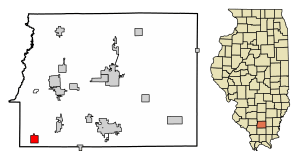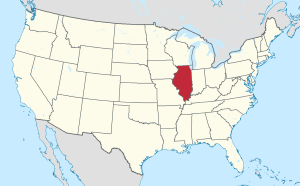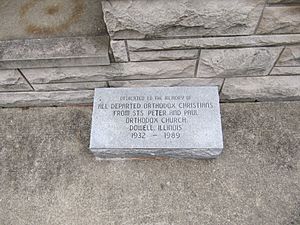Royalton, Illinois facts for kids
Quick facts for kids
Royalton, Illinois
|
|
|---|---|

Main Street
|
|

Location of Royalton in Franklin County, Illinois.
|
|

Location of Illinois in the United States
|
|
| Country | United States |
| State | Illinois |
| County | Franklin |
| Township | Six Mile |
| Area | |
| • Total | 1.12 sq mi (2.91 km2) |
| • Land | 1.11 sq mi (2.89 km2) |
| • Water | 0.01 sq mi (0.02 km2) |
| Elevation | 390 ft (120 m) |
| Population
(2020)
|
|
| • Total | 1,068 |
| • Density | 957.85/sq mi (369.81/km2) |
| Time zone | UTC-6 (CST) |
| • Summer (DST) | UTC-5 (CDT) |
| ZIP Code(s) |
62983
|
| Area code(s) | 618 |
| FIPS code | 17-66209 |
| GNIS feature ID | 417020 |
| Wikimedia Commons | Royalton, Illinois |
Royalton is a small village located in Franklin County, Illinois, in the United States. It's a place with a rich history, especially linked to coal mining. In 2020, about 1,068 people lived there. Royalton is known for its strong community spirit and its unique historical landmarks.
Contents
History of Royalton
How Royalton Got Its Name
Long ago, in the early 1800s, an old road called the Lusk's Ferry Road passed through the area where Royalton is now. This road was important for connecting different parts of Illinois.
In the 1850s, a man named Isaac Snider lived nearby. In 1856, he built a store and opened a post office. He called the area "Osage" because many Osage trees grew there. Soon, this small settlement had a few stores, a doctor, and even a telephone!
Later, in 1904, another person named Henry Pierce started a new village just north of a mine. He called it "Pierce" and moved the Osage Post Office there. But Mr. Pierce passed away soon after.
Then, in 1905, a farmer named John W. Royal owned the land next to Pierce. He also planned a village on his farm. Because his survey was recorded first, the town was officially named Royalton.
Early Settlers and Growth
Many of the first people who came to Royalton were immigrants from Europe. They came to work in the coal mines that were opening in the area. The mines brought many jobs, and Royalton grew very quickly! At one point, about 3,800 people lived there.
Geography of Royalton
Royalton is located in the southwestern part of Franklin County. You can find it at 37°52′49″N 89°6′49″W / 37.88028°N 89.11361°W. A main road, Illinois Route 149, goes right through the middle of the village. This road connects Royalton to other nearby towns like Zeigler and Hurst.
The village covers a total area of about 1.12 square miles (2.91 square kilometers). Most of this area is land, with a very small part being water.
Coal Mining in Royalton
Mines and Workers
Coal mining was a huge part of Royalton's history. In 1907, the Big Muddy and Carterville Coal Company opened the North #1 mine. Miners often lived in special box cars that were used as homes along North Main Street.
Later, the Franklin Coal & Coke Company took over this mine. They also operated another mine south of Royalton. At its busiest, the North #1 mine employed over 600 miners! Another mine, Lyda B, opened in 1949 but closed a few years later in 1952.
Mine Accidents
Mining was a dangerous job. On October 22, 1914, there was a big explosion in the North #1 Mine. Sadly, 52 miners lost their lives. Many of these miners were European immigrants. This was a very difficult time for the community. Another explosion happened in the same mine on September 28, 1918, which also caused the loss of 21 men.
The South Mine closed in 1920. The North #1 mine continued to operate until September 1951.
Protection of the Holy Virgin Mary Orthodox Church
Royalton is home to a special church called the Protection of the Holy Virgin Mary Orthodox Church. It is the only Russian Orthodox church left in southern Illinois.
Church History and Community
This church was built by immigrants from Eastern Europe, including people called Rusyns. Many of them were miners who worked in the local coal mines. Three important founders were Frank Derbak, John August, and Paul Andrews. The church opened its doors in late 1914. It was designed to look similar to another church, St. Ioasaph's in Muddy.
Many of the miners who were affected by the 1914 mine explosion were members of this church. There is a special memorial at the church to remember them. Many of these miners are also buried in a cemetery dedicated to the disaster.
There used to be another Russian Orthodox church in a nearby town called Dowell, but it has since closed. A memorial to the Dowell church is now located in Royalton.

Population and People
| Historical population | |||
|---|---|---|---|
| Census | Pop. | %± | |
| 1910 | 357 | — | |
| 1920 | 2,043 | 472.3% | |
| 1930 | 2,108 | 3.2% | |
| 1940 | 1,772 | −15.9% | |
| 1950 | 1,506 | −15.0% | |
| 1960 | 1,225 | −18.7% | |
| 1970 | 1,166 | −4.8% | |
| 1980 | 1,320 | 13.2% | |
| 1990 | 1,191 | −9.8% | |
| 2000 | 1,130 | −5.1% | |
| 2010 | 1,151 | 1.9% | |
| 2020 | 1,068 | −7.2% | |
| U.S. Decennial Census | |||
According to the 2020 census, there were 1,068 people living in Royalton. The population density was about 951 people per square mile.
Most of the people in Royalton are White. A small number of residents are African American or from other racial backgrounds. About 1.87% of the population identified as Hispanic or Latino.
The village has 540 households. About 17.4% of these households have children under 18 living with them. The average age of people in Royalton is about 49.4 years old.
See also
 In Spanish: Royalton (Illinois) para niños
In Spanish: Royalton (Illinois) para niños

